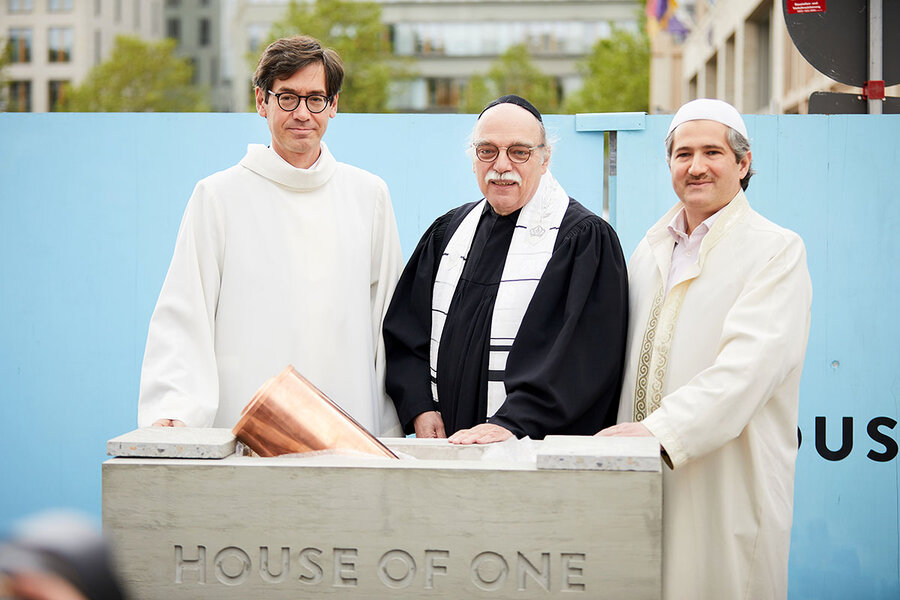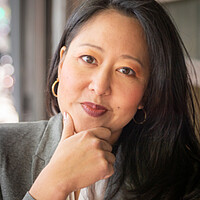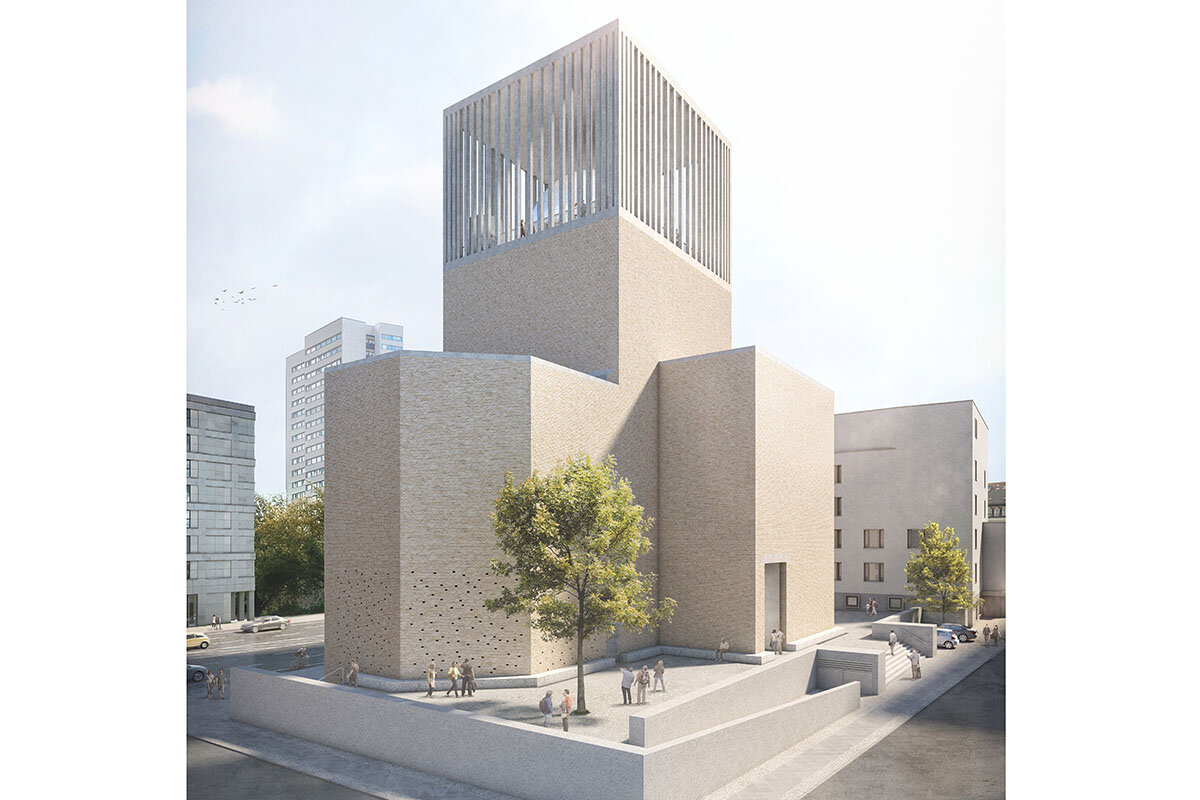A new way to foster religious tolerance? Put everyone under one roof.
Loading...
| Berlin
Betül Samhal is a practicing Muslim in “Christian country,” as she puts it. She’s found her tightknit Muslim community in Berlin where she lives, but says she’s never intimately known many Christians or Jews. Nor has she ever had the chance to talk with them about religion.
“People typically avoid people of other faiths,” says Ms. Samhal, an elementary school teacher. “People either can’t or don’t want to understand each other.”
Enter Berlin’s House of One, the world’s first planned structure that will house a synagogue, a church, and a mosque under one roof.
Why We Wrote This
Religion can sometimes throw up walls between different believers. The House of One in Berlin is specifically being built to combat that.
It’s four years away from completion, but the community has already provided Ms. Samhal with a formal structure in which to mingle with Christians and Jews. She’s also been able to present to people of all faiths about Islam, and vice versa. Recently, she had an audience of 70. There isn’t “just one Islam,” Ms. Samhal told the group, and she also addressed a misconception about women by explaining that each branch of Islam sees women very differently.
“Then we went to a mosque, and the second day we went to a church, and the third day to a synagogue,” says Ms. Samhal. “Three religions under one roof allows space for dialogue – our discussions dismantle stereotypes we may have had about other religions.”
Borne of the efforts of an imam, a rabbi, and a Protestant minister, the House of One broke ground in May after a decade of negotiations and fundraising. With money from private parties as well as the city and federal governments, the House of One is intended to cultivate diversity and tolerance of other religions during a time of global chaos and strife. Supporters say the House of One is already gathering communities – and fostering dialogue.
“It’s urgently necessary to enlighten the religious-exclusives, those people who believe their way to God is the only right way. This project forces them to question those thoughts, and to think about diversity within religion,” says Mouhanad Khorchide, director of the Center for Islamic Theology at the University of Münster and a member of the House of One Board of Trustees. “I can’t tell you if the House of One is going to be a success yet or not. But the symbolism of the project is that it shows these three religions can get along, not that everyone does get along.”
Taking responsibility together
The first stone was laid in May in Petriplatz, on the foundation of a former 13th-century church to St. Peter. It was essentially the birthplace of Berlin.
The design for the House of One was put out to competition, won by a Berlin-based architecture firm, and will consist of three distinct boxy wings that join into one large structure. Each faith will have its own space, arranged around a central hall where people can encounter each other in a public area.
The support of the political class is clear – the Bundestag (a federal legislative body) contributed €10 million ($11.8 million) and the city of Berlin €10 million, with the roughly €20 million remaining coming from private donations from people in more than 60 countries. And the goals of the founders are as lofty as the design.
“The House of One wants to contribute to world peace,” says Imam Kadir Sancı, “and it’s important that Jews, Christians, and Muslims take responsibility together and work on an equal footing. Because they have often shown in history how to rival.”
In other words, the social divisions sown by diversity must be healed, and no one can solve these rifts alone. For House of One co-“initiators” Mr. Sancı, Rabbi Tovia Ben-Chorin, and the Rev. Gregor Höhberg, religion is an ideal place to bring people together. After all, 85% of people in the world belong to a religion.
Along those lines, the House of One will be a place of learning and education, since teaching about religions can promote respect and cross-cultural understanding. It can also dispel stereotypes, says Mr. Höhberg. Religion offers a wealth of experience to show people of “different religions, cultures, and origins how to co-exist peacefully,” he adds.
Encouraging religious integration
Critics of the project are plentiful. Who will actually worship there, when distinct places of faith – synagogues, churches, mosques – have long been embedded within Berlin neighborhoods, with deep connections to their residents?
Further, a common criticism of interreligious dialogue is that it can make members feel out of touch with their own religion. Some Muslims have criticized the project because of the involvement of Forum Dialog e.V., a Muslim organization connected with the Gülen movement, which has been banned in Turkey, says Dr. Khorchide.
Still, the optimism around the House of One is strong. And the criticism that interfaith dialogue waters down one’s own religious passion? “Years of experience show that dialogue awakens in people the need to get to know their own religion better and more intensively,” explains Mr. Sancı.
Dr. Khorchide nods to the tremendous potential for the project to change the dialogue on a civil, theological, and political level. “When we laid the first stone, the former president of Germany was there,” he says. “The state is funding more than half of this project. Politicians in Germany are very invested in encouraging religions’ integration – it’s a clear signal.”
One signal the House of One does send is that Islamophobia and antisemitism will not be tolerated.
Whether such goals come to pass, Ms. Samhal says she’s already befriended Jews that she now sees socially.
“As a Muslim you don’t often get a chance to speak with Jewish people,” she says, “and I was so excited to be able to make friends and get their perspective on things.”







